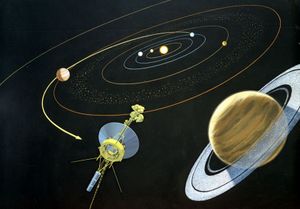105-2019201 Practice
How to break free from the Sun (The journey of Voyager 1 part 1)
Mariner-Jupiter-Saturn 1977 Spacecraft Artwork, 1975 NASA and JPL initially referred to what became the Voyagers as the Mariner-Jupiter-Saturn 1977 Project. The two Voyagers were advanced versions of the Mariner-class spacecraft that JPL had flown successfully to Venus, Mars, and Mercury. Shown here is a 1975 JPL artist's rendering of Voyager after encountering Jupiter and, after a gravity assist, approaching Saturn.
Question 1
Delta-v (literally "change in velocity"), symbolised as ∆v and pronounced delta-vee, as used in spacecraft flight dynamics, is a measure of the impulse per unit of spacecraft mass that is needed to perform a maneuver such as launch from, or landing on a planet or moon, or in-space orbital maneuver. It is a scalar that has the units of speed. As used in this context, it is not the same as the physical change in velocity of the vehicle.
When rocket thrust is applied in short bursts the other sources of acceleration may be negligible, and ∆v becomes
As a simple example, take a conventional rocket which achieves thrust by burning fuel. Delta-v is the change in velocity that can be achieved by burning that rocket's entire fuel load.
(a)
Is it possible to calculate delta-v requirements of an orbital maneuver from conservation of energy by considering only the total energy of the vehicle in the initial and final orbits?
(b)
Orbit maneuvers are made by firing a thruster to produce a reaction force acting on the spacecraft. The size of this force will be
where is the velocity of the exhaust gas in rocket frame and is the propellant flow rate to the combustion chamber.
Assuming to be a constant not depending on the amount of fuel left prove the ∆v is given by Tsiolkovsky rocket equation.
where is the initial mass of the spacecraft (before the thrust), and is the final mass of the spacecraft (after the thrust).







